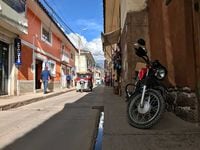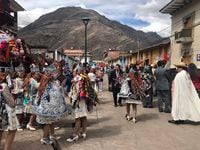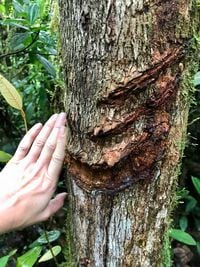My breath rate increases as the sound of my tires on the pavement becomes dampened in the fog. I am enveloped in light, reflected by water droplets suspended in the air. I see nothing but white and hear only the sound of my breathing confined in my helmet. The all-consuming nothingness of a whiteout is not new to me, especially within the last few months of riding around this topographically diverse nation.
Sign up here to receive our newsletters. Get the latest in motorcycle reviews, tests, and industry news, subscribe here for our YouTube channel.
Ecuador is a relatively small country, but within its biodiversity-rich political boundaries, I’ve experienced more whiteouts here while motorcycle touring than anywhere else.
Related: Trapped Abroad On A Motorcycle Trip During Coronavirus
There is something about the way the dramatic peaks of the Andes Mountains capture moisture, holding it hostage as a perpetual cloud. On both sides, evaporation from the Pacific Ocean and the Amazon jungle rests as a misty blanket just above the dew point. There is nothing such fog yields to; everything is permeated by moisture. Riding in these conditions is like traveling through a dream, a mysterious context constructed in your subconscious as you advance further into the unknown.
There are no wide-open-throttle moments here. I’ve found that regardless of the quantity of “cat crap” on my visor, it’s going to be a challenge to see well (or at all). If there’s anything I’ve learned from riding in South America (and elsewhere), it’s to never ride faster than you can see. The road quality is questionable; potholes are often lethal, and sometimes the pavement simply ends without warning, dropping off into a surprise gravel pit, rutted mud tracks, or is simply overrun by a herd of cattle, goats, or camelids. Even on some of the better roads, there’s no telling what’s ahead. Therefore, if your vision is greatly reduced, so is your speed.
Related: Adventure Motorcycles
It was here on the sweeping curves of the Eastern Cordillera mountain road between the Andes and the Amazon that I experienced the first of many Ecuadorian whiteouts. The Papallacta Pass is a scenic ride which takes you through several small towns and Andean villages before ascending to 4,064 meters (13,333 feet). With glacial views, an added layer of clothing is recommended for this section of the ride.
There are many hot springs in this volcanic alpine wonderland. The paramo de Papallacta is high-altitude grasslands, dotted by lakes brimming with trout, a grilled speciality at local restaurants. This pass is the continental divide, with views of the Antisana volcano peaks on the horizon. This road is in good condition and home to some glorious twisties, as long as your visibility is better than mine was.
Shrouded in white at the precipice of the mountain pass, I began to see caution signs warning of spectacled bear crossings. The only bear in South America, and vulnerable in their existence, these bears are rare and therefore difficult to observe in their natural habitat. Although I was weary from being wet and cold on a long ride from the eastern Colombian border crossing, I became filled with excitement for the prospect of seeing a spectacled bear. As I stood up on my pegs for warmth, my body shaking from the cold, my hands and feet totally numb, scanning for endangered wildlife took my mind off the challenges of the elevation. I never saw a bear that day, but just the idea of the possibility of spotting one helped me persevere through a tough time.
Descending from the peak toward the Amazon, the ecosystems transformed from alpine to tropical jungle.
The glorious curves took me into a small town nestled in the tropical slopes of the Andes where a local pointed up at the lush hillside, saying, “You see those avocado trees? Sometimes you can see bears right from the town, eating those fruits.” I stared at the hillside plot of trees, surrounded by forest, imagining a creature like one of the black bears I’ve seen in North Carolina, except with creamy markings on its face, encircling the eyes like eyeglasses, emerging from the forest edges to raid the cultivated avocados. Transfixed on the hillside, I wondered how long I’d have to stare before this imagined vision manifested into reality. The local then turned his gaze back to the street and resumed walking. Moments later, I did too.
The next morning a flat tire delayed my departure and left me wondering if that was the opportunity I needed to catch a glimpse of the crop-raiding spectacled bears. I stared at the screw in my hand, freshly pulled from the puncture wound of my tubeless rear tire, trying to materialize meaning in its form. After a handful of empty glances up at the hillside and a freshly plugged tire, I departed.
Observing spectacled bears in the wild has started to seem like an optical trick to me; the more I look for them, the more illusory they become.
Solitary and elusive, these bears practice social distancing for most of their lives, generally only coming together to mate and occasionally feast on a plethora of ripened fruits. Due to the remoteness of the territories they live in, their interaction with humans is minimal, which is why the first stories of these bears were cultivated as legends.
Just as these elevated Andean mountain passes demand respect, so do the spectacled bears of the Quechua myths. Due to the bears’ somewhat human-like appearance, the stories of lore are of bears mating with women (usually stolen or lured into caves where they are held captive) to produce half bear-half human offspring. The hybrid creature, known as “ukuku” is generally feared by all due to their supernatural strength and propensity to decimate crops, especially corn.
During a syncretic festival (known as Quyllurit’i) in the Cusco region of Peru, people dress up as ukukus, wearing dark fibered coats and woolen masks. Their character assumes the role of trickster, playing pranks and squealing in high-pitched voices as they make their way on a courageous pilgrimage up to the glacier. Traditionally their task was to carry back blocks of ice on their backs, the frozen water imbued with medicinal and healing qualities. Nowadays, due to the recent melting of this glacier, this icy ritual is no longer possible.
The chilly winds whip around at these altitudes, riding among snowcapped peaks, frozen waterfalls, and only herds of well-insulated alpacas looking content. The tales of fur-covered, human-like creatures roll around in my mind as the road switches back and forth, up and down over countless mountains. Sometimes I’ll see elderly locals, walking on the side of the road in their ponchos, hobbled over with a large bundle of sticks on their backs. I’ve always been impressed by this sight; often it is an old woman, at least the age of my grandmother carrying a large load of wood on her stooped shoulders. With nothing around us, I can’t help but wonder: Where is she going? How far is she walking? If I had some extra room on my fully packed bike, I would offer her a lift. Now, riding in the middle of nowhere with my mind steeped in legends of ukukus, I turn back to see their faces, to see if they are covered in fur.
Like any worthwhile destination, the best part about seeking the Andean bear is the journey itself. The roads which lead you to their habitats are rugged and wild, just like the bears themselves.
If you decide to seek out these trickster phantoms, you’ll find that riding to where spectacled bears gather will take you through an incredible diversity of landscapes, from glaciers to alpine grasslands to tropical mountain forests—surprisingly quickly. And thank goodness, because even though the bears inhabit altitudes up to 4,500 meters, higher than the elevation of the Papallacta Pass, I prefer to look for them a bit lower than that, where life is less harsh.
It is shocking how immediate the change in environment is—how rapidly the switchbacks take you into what feels like another world. Such is the stunning ride from Quito down into the montane cloud forests west of the Andes. Less than an hour away from the bustling metropolis of Ecuador’s capital, just behind the Pichincha Volcano, you’ll find the Yanacocha Reserve. The road heads toward the town of Nono, a path also known as the Paseo del Quinde Ecoroute. The first section is paved but then becomes large cobblestones, until the road deteriorates to dirt. Blink and you’ll miss the point at which the scenery transforms. The Yanacocha reserve is high evergreen forest, including Polylepis trees, a strange tree with a peeling bark that was once used as paper.
The road is once again enveloped in trees clustered with bromeliads, the hitchhiking plants which settle on the branches of trees and collect nourishment and water from the air. Not exactly parasites, these epiphytic plants only harm the trees they have perched on when they get so heavy that the branches break off the trees, falling to the earth. The spectacled bears love eating bromeliads and possess the excellent tree climbing skills needed to reach them.
Heading beyond Nono, northwest toward the famous cloud forests of Mindo and then north to the little town of Nanegal, you’ll find the dirt road that leads to Maquipucuna. Following the dirt path over rivers and past small farms, the lush vegetation of the Maquipucuna Reserve rainforest thickens. Maquipucuna consists of 6,500 hectares (16,062 acres) of protected forest in the clouds, and the best location to see spectacled bears anywhere in the world. It is here that the bears forego their solitary ways to gather when the aguacatillo fruits are ripe.
The team at Maquipucuna has counted at least 45 bears within 200 hectares, an extraordinary number since typically you’ll only see a single, lonely bear per 1,000 hectares. Considered endangered in Ecuador, spectacled bear populations have actually been increasing around the Maquipucuna reserve. It is here, for a few weeks a year, you’ll find the highest concentration of spectacled bears anywhere in the wild.
A wooden bridge crosses from the dirt path over the Umachaca River to the entrance of the Maquipucuna Ecolodge. Everything is made of wood and cane, with hammocks swaying at eye level to an incredible array of exotic birds, butterflies, and moths.
Funny thing is, we humans never know exactly when the aguacatillos will be ripe. The team anticipates ripened fruits filled with nutritious fats and ready to be consumed by hungry bears approximately eight months after the flowering of their trees. Perhaps fittingly, they were not ripe upon my visit to the Maquipucuna Reserve. Thus, my search continues. Thankfully, the journey remains every bit as wonderful as the goal.



























/cloudfront-us-east-1.images.arcpublishing.com/octane/2WF3SCE3NFBQXLDNJM7KMXA45E.jpg)
/cloudfront-us-east-1.images.arcpublishing.com/octane/G4MG6OUCJNBSHIS2MVVOTPX65E.jpg)
/cloudfront-us-east-1.images.arcpublishing.com/octane/IIGGWFOTOJGB7DB6DGBXCCMTDY.jpg)
/cloudfront-us-east-1.images.arcpublishing.com/octane/QSTCM6AVEZA5JJBUXNIQ3DSOF4.jpg)
/cloudfront-us-east-1.images.arcpublishing.com/octane/U4I7G625B5DMLF2DVIJDFZVV6M.jpg)
/cloudfront-us-east-1.images.arcpublishing.com/octane/B6XD6LS6IVCQPIU6HXDJSM3FHY.jpg)
/cloudfront-us-east-1.images.arcpublishing.com/octane/ICL63FEDDRDTTMINYICCEYGMDA.jpg)
/cloudfront-us-east-1.images.arcpublishing.com/octane/FCGZHQXRBZFLBAPC5SDIQLVF4I.jpg)
/cloudfront-us-east-1.images.arcpublishing.com/octane/WNOB6LDOIFFHJKPSVIWDYUGOPM.jpg)

/cloudfront-us-east-1.images.arcpublishing.com/octane/X33NU3E525ECRHXLNUJN2FTRKI.jpg)
/cloudfront-us-east-1.images.arcpublishing.com/octane/6KKT5NNL2JAVBOXMZYS5ZO76YA.jpg)
/cloudfront-us-east-1.images.arcpublishing.com/octane/J5RKG5O455GMPGQRF2OG6LRT7A.jpg)
/cloudfront-us-east-1.images.arcpublishing.com/octane/GX2CIZKQVRH2TATDM26KFG2DAE.jpg)
/cloudfront-us-east-1.images.arcpublishing.com/octane/ZWIDYSAKQZHD5BHREMQILXJCGM.jpg)
/cloudfront-us-east-1.images.arcpublishing.com/octane/CYUHJZCTSJCH3MRAQEIKXK7SCQ.jpg)
/cloudfront-us-east-1.images.arcpublishing.com/octane/LKOFINY56FCXJCANJ5M7ZDQUBY.jpg)
/cloudfront-us-east-1.images.arcpublishing.com/octane/4NBPDACMWJH63JQYJVK3QRBDZI.jpg)
/cloudfront-us-east-1.images.arcpublishing.com/octane/KKHQHRR3FJGX7H2IPU6RALMWG4.jpg)

/cloudfront-us-east-1.images.arcpublishing.com/octane/5IOFS5JAE5FOXMNA23ZRAVVYUU.jpg)
/cloudfront-us-east-1.images.arcpublishing.com/octane/CGXQ3O2VVJF7PGTYR3QICTLDLM.jpg)

/cloudfront-us-east-1.images.arcpublishing.com/octane/OQVCJOABCFC5NBEF2KIGRCV3XA.jpg)